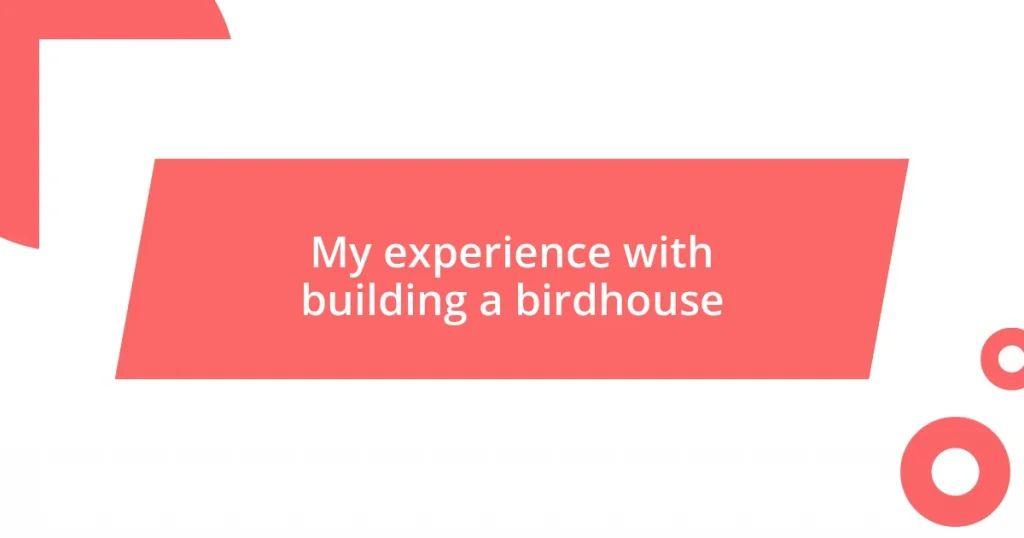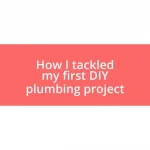Key takeaways:
- Choosing durable, non-toxic materials like cedar and composite wood is essential for the longevity and safety of the birdhouse.
- Designing the birdhouse with specific features such as proper ventilation, drainage, and appropriate entrance hole sizes is crucial for accommodating various bird species.
- Regular maintenance, including monthly checks and seasonal cleanings, ensures the birdhouse remains a safe and inviting home for birds.

Choosing the right materials
When I first embarked on my birdhouse project, the choice of materials felt overwhelming. I remember standing in the hardware store, staring at stacks of wood, thinking about whether to go with cedar or pine. Cedar quickly became my top pick because it’s naturally resistant to rot and insects, which means less maintenance for me down the line.
While I was selecting materials, I also pondered the importance of using non-toxic finishes. After all, who would want to inadvertently harm the birds that would soon call my creation home? This thought stuck with me, driving me to choose environmentally friendly options. It made me feel good to know my choices would help create a safe haven for my feathered friends.
Durability became a key factor as I considered the weather conditions in my area. I recall my excitement when I discovered a composite wood alternative that promised both longevity and resistance to harsh elements. Have you ever felt that sense of triumph when you find the perfect solution to a problem? That’s exactly what I experienced, and it made the whole building process much more fulfilling.
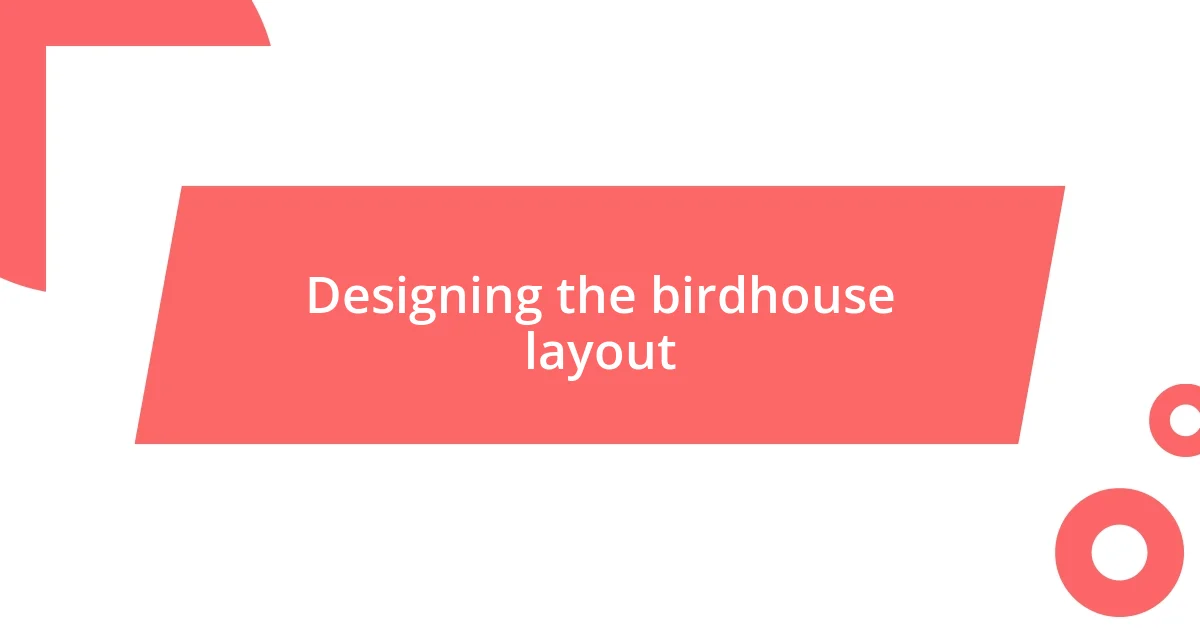
Designing the birdhouse layout
When it came to designing the layout of my birdhouse, I wanted to create a space that not only looked inviting but also met the needs of the different bird species in my area. I spent plenty of time sketching various designs, trying to imagine how each feature would come together. I recall the moment I finally settled on a simple yet effective design that included proper ventilation and drainage because, let’s face it, no bird wants to live in a damp house!
Here are some key aspects I focused on when designing the layout:
- Entrance Hole Size: I learned that different bird species require specific entrance hole sizes; for instance, chickadees prefer a 1.25-inch opening.
- Height and Positioning: I positioned the birdhouse at least five feet off the ground, considering the protection from predators.
- Overhang: Adding an overhang helped keep rain out, ensuring a dry interior.
- Internal Dimensions: Keeping the internal space cozy promotes a sense of security, which is crucial for nesting.
I also took inspiration from various styles, and I remember feeling excited about incorporating some decorative elements that would make the birdhouse unique. It was gratifying to think that my design would not just cater to functionality but also provide a charming addition to the landscape. Each decision felt like a new adventure, and as I reflected on my choices, I felt a deep connection to the natural world and its inhabitants.
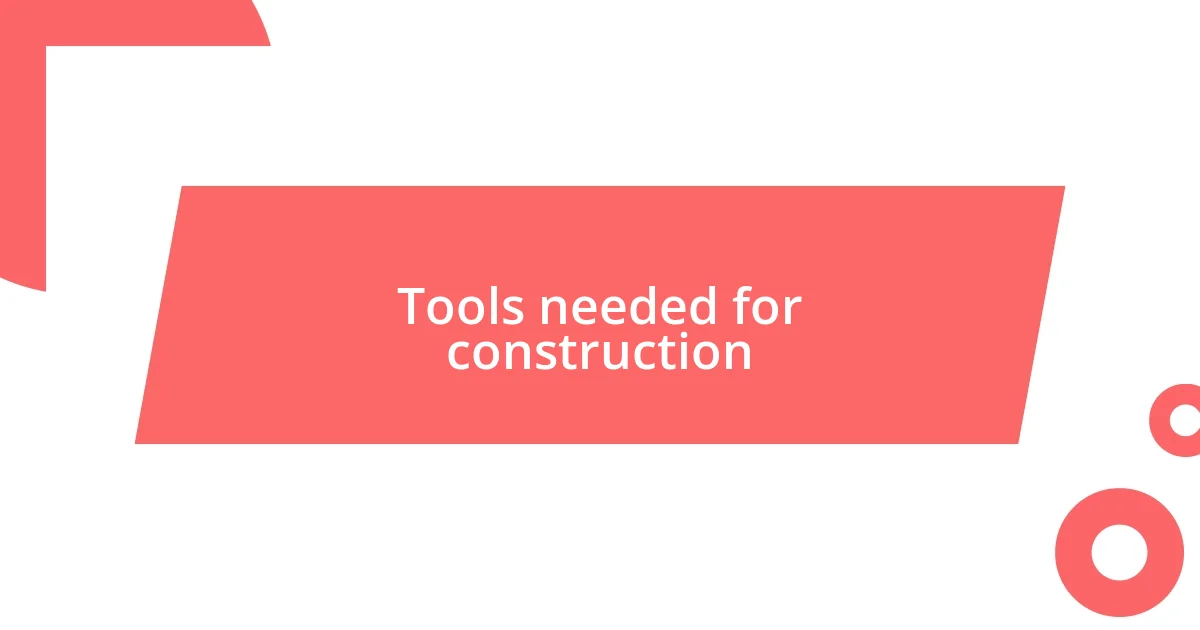
Tools needed for construction
Building a birdhouse requires a handful of essential tools, and getting the right ones can truly make a difference. I remember my first trip to gather supplies; it felt almost like gathering tools for a treasure hunt! A saw is crucial for cutting the wood to size; I personally prefer a miter saw for its accuracy and ease of use. Then there’s the drill, which I found indispensable not just for assembling pieces but also for making those perfectly-sized entrance holes. Have you ever been halfway through a project and realized you’re missing a key tool? I certainly have, and it definitely slows the excitement.
Other tools like a measuring tape and square help ensure that everything fits together snugly. I can’t emphasize enough how useful a level is as well, especially if you want your birdhouse to hang evenly and look pleasing to the eye. It’s little things like these that contribute to a well-crafted end product. Trust me; there’s nothing more rewarding than seeing your birdhouse take shape with precision and care, all thanks to the right tools.
Finally, a safety kit is part of this equation. A simple pair of safety goggles can be the difference between a fun project and a painful one. I remember the one time I got a tiny wood splinter in my eye while working; it was a lesson learned the hard way! I always advise friends to take safety seriously when building. Preparing with the right tools isn’t just about efficiency; it’s also about enjoying the process without unnecessary mishaps.
| Tool | Purpose |
|---|---|
| Saw | Cutting wood to size |
| Drill | Assembling pieces and drilling holes |
| Measuring tape | Measuring dimensions |
| Square | Ensuring right angles |
| Level | Making sure the birdhouse hangs evenly |
| Safety goggles | Protecting your eyes |
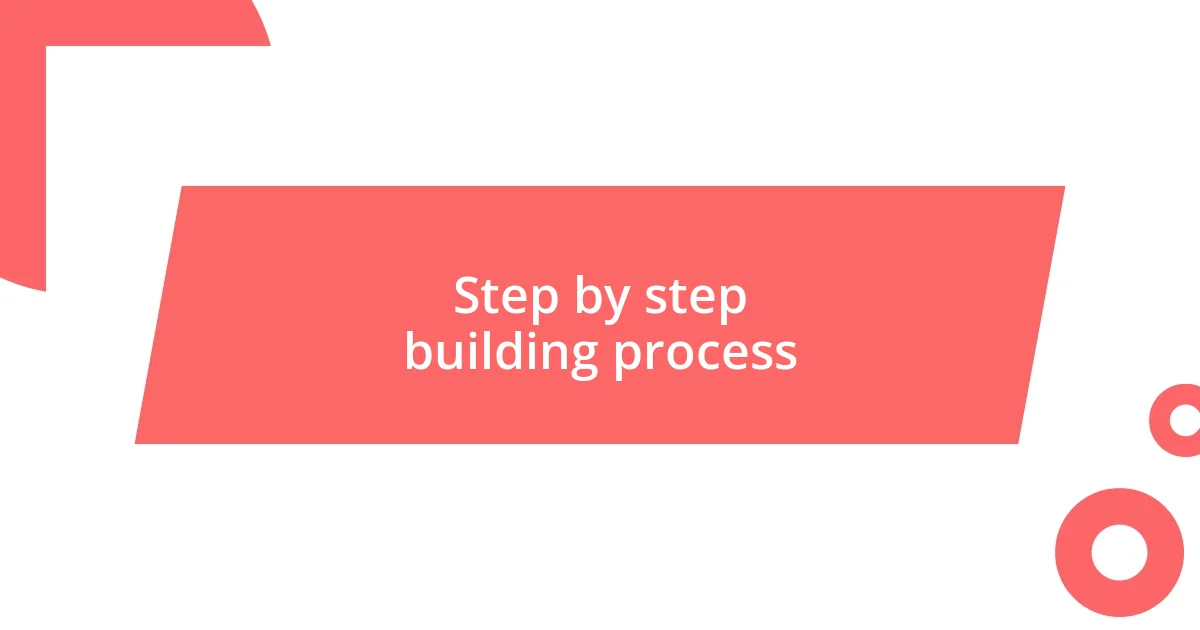
Step by step building process
Once I had my tools ready, I dove right into the construction process, starting with the wooden pieces I had carefully measured and cut. I was so eager to see the birdhouse take shape that the smell of fresh wood was invigorating, even inspiring! Assembling the walls together was straightforward, but I vividly remember the moment I realized that pre-drilling the holes for screws saved me a lot of frustration—not to mention the importance of preventing the wood from splitting. Have you ever faced a hurdle when you thought everything would go smoothly? It’s those little adjustments that make a big impact.
Next, I focused on the roof. To me, the roof is like the hat of the birdhouse—it needs to fit well and be stylish! While attaching the roof panels, I made sure to leave a slight overhang, which not only adds to the aesthetic but also helps protect the entrance from rain. I remember double-checking the angles; nothing felt worse than having to re-do work because I hadn’t measured correctly. It’s a lesson I’ve learned through my own blunders, and it certainly brought out the perfectionist in me!
Once everything was assembled, I moved on to sanding the edges. I’ll never forget the satisfaction of smoothing everything out; it felt like applying the finishing touches on a masterpiece. This step might seem small, but I assure you, it enhances safety and the overall look tremendously. It’s these moments of care that transform a simple structure into a cozy sanctuary for birds—a reminder that even in the small details, you can find joy and fulfillment. Wouldn’t you agree that the effort we put into our projects shows through in the end result?

Finishing touches and painting
As I approached the final stages of my birdhouse project, I couldn’t help but feel a mix of excitement and nervousness. Choosing the right paint was like selecting colors for my own living space; it needed to reflect my personality but also be practical. I went with non-toxic, eco-friendly paint, keeping in mind that the health of the birds was paramount. Have you ever felt that sense of responsibility when creating something for someone else? It’s profound, and it made me take a step back to appreciate the project.
When it came time to apply the finishing touches, I opted for a paintbrush for precision over a spray can. There’s something about the act of painting that feels meditative; I loved getting lost in the rhythm of each stroke. I also added a playful touch—dabbing some splashes of different colors just for fun! Watching the birdhouse transform under my brush was nothing short of magical. Do you know that feeling when you see your work start to shine? It’s immensely satisfying.
Finally, I accented my birdhouse with a weatherproof sealant, which added both a glossy finish and protection against the elements. I learned from past projects that durability is key, especially with outdoor structures exposed to rain and sun. I remember standing back and admiring my work, feeling that perhaps I had crafted not just a birdhouse, but a little haven for the feathered friends that would soon come calling. Hasn’t that anticipation of life returning to a creation ever filled you with excitement, too? It certainly left me eager to see how my efforts would ultimately pay off!
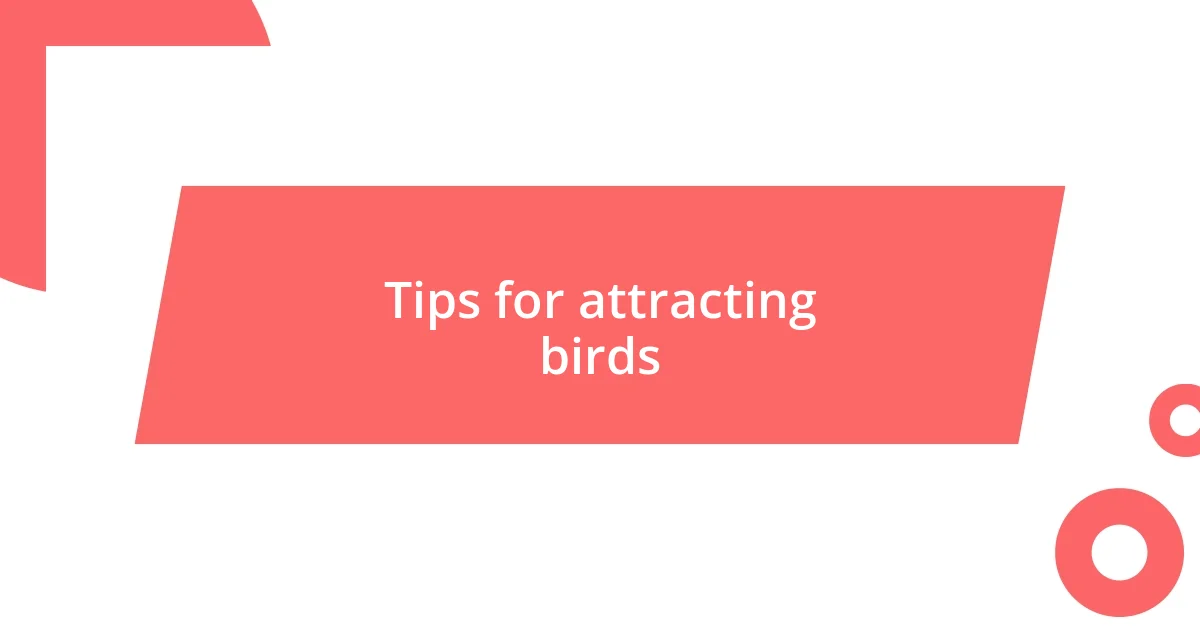
Tips for attracting birds
To attract birds to your newly built birdhouse, consider placing it in a quiet location, away from heavy foot traffic and potential predators. I remember the first time I chose the perfect spot for my birdhouse; it was nestled among the trees, offering a sense of security for its future residents. Have you ever thought about how environment can impact bird behavior? A peaceful setting encourages birds to explore and settle in comfortably.
Another tip is to offer food and water nearby. When I added a small birdbath to my yard, it was like I had rolled out the welcome mat for feathered guests. The sight of birds splashing in the water was sheer delight! This simple act creates a habitat that attracts not just species, but also brings a sense of joy and connection to nature. Don’t you love watching birds interact? It turns your backyard into a lively show.
Additionally, using natural materials for your birdhouse can make a big difference. I purposely left some rough areas on the wood because they provide grip for nesting birds. It’s those little touches that truly invite them in. Have you ever noticed how certain materials seem to resonate better with wildlife? Embracing nature’s textures can foster a sense of belonging for our avian friends.
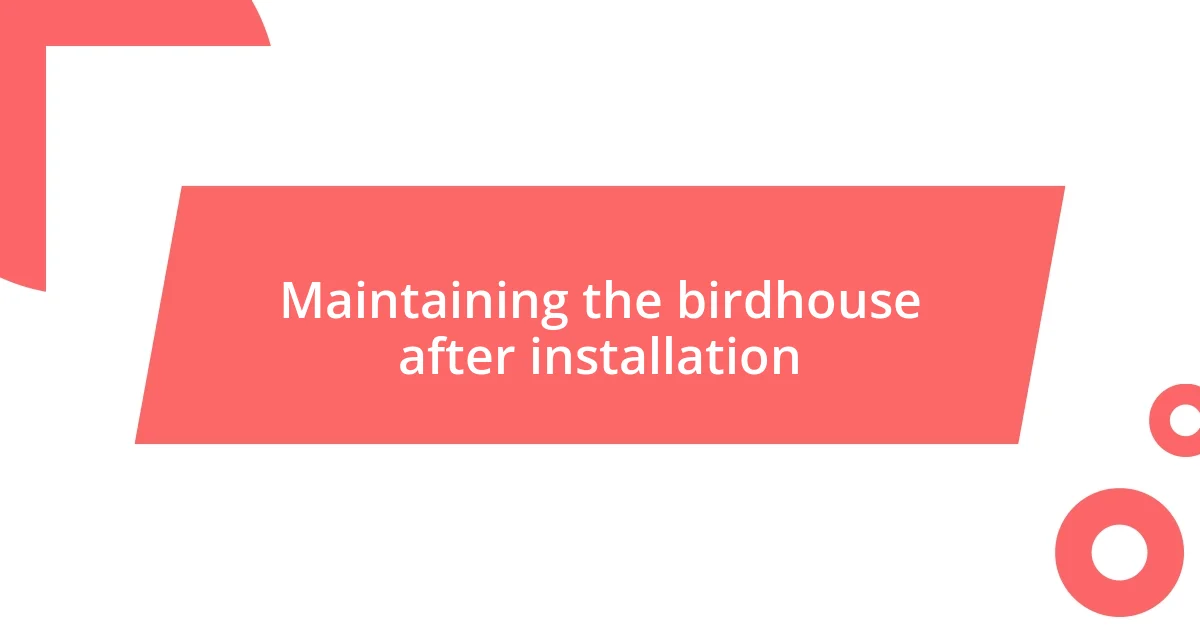
Maintaining the birdhouse after installation
Maintaining a birdhouse after installation is crucial to ensure it remains a safe haven for its inhabitants. I quickly learned that regular checks—about once a month—can help catch any signs of wear or damage. Have you ever noticed how a small repair can prevent a bigger issue down the road? That’s exactly what I found when I noticed a loose shingle; tightening it immediately saved me from potential leakage during the rainy season.
Cleaning is another important aspect of maintenance. Each fall, I take the time to clear out old nesting materials. It’s a simple task, but it feels so rewarding, almost like a spring cleaning for my feathered friends. I always think, “Wouldn’t you want to move into a fresh, clean space?” Providing a tidy environment encourages birds to return and fosters a healthy nesting experience.
Weather protection shouldn’t be overlooked either. I remember my first winter with the birdhouse—inspecting it closely revealed a little wear from the harsh elements. Since then, I’ve added an extra layer of weatherproofing and ensured it’s positioned away from direct wind. How comforting it is to know that my little project can withstand the seasons! Taking these maintenance steps not only extends the life of the birdhouse but also reinforces my connection to the wildlife that graces my yard.










